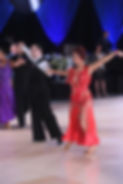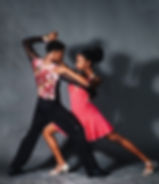American Tango For Beginners
- info1802274
- Jul 17, 2021
- 5 min read
Updated: Nov 23, 2024
What comes to mind when you think of Tango? Do you think of passion, intensity, or maybe you picture dancers in the infamous Promenade Position with a rose in their mouth? These are a few of the many characteristics of Tango. If you have taken Tango lessons before, you would probably agree that it takes time and practice to be able to get into the Tango character when you first learn the patterns. Tango is a challenging, and FUN dance that I recommend you give a try! Below is a look into what will be covered in this post.
· Tango history and characteristics · Musical information · Dancing the Basic · Connecting with your partner · Putting it all together
Tango History and Characteristics
Tango was born in the slums of Buenos Aires in the late 19th century, and it became very popular in the United States just before WW1. It all started when gauchos and migrating blacks traded cultural rhythms and dance steps in the brothels of Argentina. From this mix of cultures, the Tango emerged. Like the Waltz, there was controversy with this dance and the higher classes shunned it. As it became popular in the states, there were Tango dance halls opening all over and big hotels would host Tango teas. Although the dance varied from dancer to dancer, Tango eventually became standardized in the 1920’s. Today, there are three different styles of Tango: Argentine Tango, American Tango, and International Tango.
This post is focused on American Style Tango. This dance is very dramatic and is characterized by a close, compact hold, low center of gravity, and strong use of contra body movement. The “slow” walks in Tango are stealthy, like a cat, and we attack the “quicks” with sharp, staccato movements. In the next section, I’ll go into more detail about what slow and quick means, among other musical information.
TANGO MUSIC
The most common instruments you will notice in Tango music is the double bass, guitar, violin, and piano, and the tempo ranges between 30-32 measures per minute. As a beginner, you will count using slows (2 beats) and quicks (1 beat). As you advance, you will want to count using numbers. Every pattern will equal eight counts, and there are many rhythms used in Tango. Some of the basic rhythms are SS QQS, QQS QQS, SSQQ SSQQ QQS. Below are a few great songs you can dance Tango to:
Essa: https://youtu.be/Nn1v02eLKr8 Bad Guy: https://youtu.be/DYgKkzyk4Yc Sweet Dreams: https://youtu.be/Xu3AjfZyg6k
Dancing the Basic – American Tango
Before taking any steps, you want to make sure to stand in good postural alignment. To do this, your head should be over your shoulders, shoulders over your ribs, and ribs over your hips. As mentioned earlier, one of the characteristics of this dance is its low center of gravity. That means your knees will be in a slightly flexed position throughout the dance with your weight balanced over the center of your standing foot. Now that you are ready to dance, I will break down the Basic Step for both leaders and followers.

2017 Michigan Dance Challenge, hosted by Mark Brock.
Leader’s steps: You will begin by taking three forward walks starting with your left foot. Next, step to the side with your right foot, then drag your left foot towards your right foot without changing weight. Your first two steps forward are slow counts, equaling four counts total. Then, you finish with what’s called a Tango Close, which is one forward step followed by a side step and drag. The timing for the Tango Close is quick quick slow – the forward step is one beat, the side step is one beat, and the drag is two beats.
Leader’s footwork: All the forward walks are heel leads which means you place your heel on the floor first then roll through the foot. The side step is taken with the inside edge of your right foot making sure to roll from the ball to the heel of your foot. On the drag, you will slide your foot in with pressure on the ball of your left foot as if you are trying to discretely slide a $100 bill you see on the floor closer to you.
Follower’s steps: You will begin by taking three back walks starting with your right foot. Next, step to the side with your left foot and drag your right foot towards your left without changing weight. Your first two steps back are slow counts, equaling four counts total. Then, you finish with a Tango Close, which is one back step followed by a side step and drag. The Tango Close has a quick quick slow timing with the back step taking one beat, the side step taking one beat, and the drag taking two beats.
Follower’s footwork: On the back walks, you will roll from the ball to the middle of your foot on each step. When stepping to the side, place the inside edge of your ball, then heel down and as you place your weight on the left foot, you will roll onto the whole foot. When dragging your right foot in, place pressure only on the ball of the foot and keep the heel lifted slightly from the floor.
Adding character: Imagine you are dancing in a room with low ceilings and if you rise out of your knees you will hit your head – try to maintain this height throughout the Basic. On the first two walks you want to be stealthy with the steps, almost cat-like. Then you will speed up to attack the first quick, then slow down as you step side and drag your free foot in. Tango Technique video: https://youtu.be/LhV4GPlSor4
How to Connect with Your Partner In Tango

Teen Couple dancing american tango
The frame in Tango is very different from other smooth dances; it’s more compact due to the rotation needed, lack of swing, and low center of gravity. To get into a closed position, begin standing one foot away from your partner with the leader’s weight on their right foot and the follower’s weight on their left foot. The leader will extend their left arm forward to invite the follower in. The follower will then place her right hand in her partner’s left and take two steps (right then left) to close the gap between them as the leader pulls his left elbow back until it makes a 90° angle, and the forearm is parallel to the floor. The leader will then place his right arm on the follower’s back and his fingertips should be just touching the middle of the follower’s spine. The follower will take her left arm and hook her elbow just under the leader’s elbow and place her hand under the back of his arm with her fingers closed together. Dancers should maintain an offset position with the follower to the right of the leader, and the follower should be stretching slightly leftwards. Once you get into position, you will be ready to dance the Basic with your partner!
To get a visual of how to get into a closed position, check out this video here: https://youtu.be/NYl7XVIMWeU
Putting it All Together
Now that you have learned your Basic Step and how to connect with your partner, it’s time to put everything together. First, dance the basic without music and count SS QQS a few times to get comfortable moving with someone else. The Basic can go in a straight line, or you can try curving it to the left so that you can dance around the floor. Once you get the hang of it, try adding music. Check out this video of the Straight Basic: https://youtu.be/ZTn4LyCZEwk
Thank you for reading this post. Tango is so much fun and I hope that you are inspired to learn more! This dance can be challenging, so keep working on it and it will get better and better with practice.
